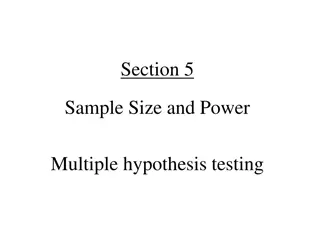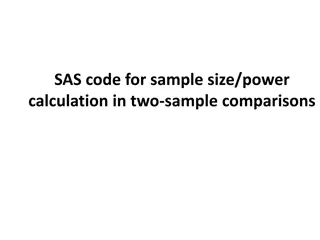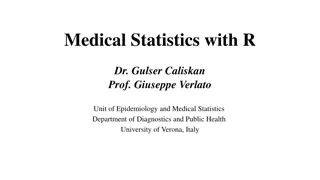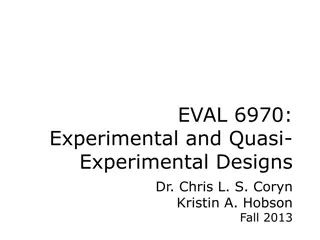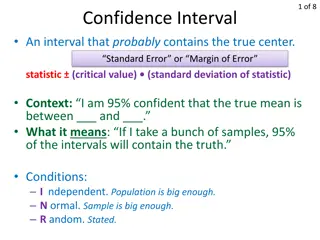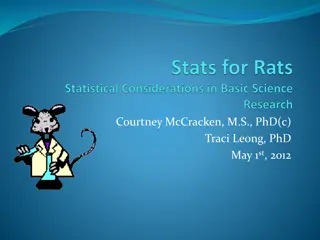Understanding Sample Size and Statistical Power in Experimental Design
Learn about the importance of determining optimal sample sizes to detect differences between groups in experiments. Explore biological hypotheses, statistical implications, types of errors, acceptance/rejection probabilities, factors influencing statistical power, and the significance of Type I and Type II errors.
Download Presentation

Please find below an Image/Link to download the presentation.
The content on the website is provided AS IS for your information and personal use only. It may not be sold, licensed, or shared on other websites without obtaining consent from the author. Download presentation by click this link. If you encounter any issues during the download, it is possible that the publisher has removed the file from their server.
E N D
Presentation Transcript
Designing Experiments: Sample Size and Statistical Power Larry Leamy Department of Biology University of North Carolina at Charlotte Charlotte, NC 28223
INTRODUCTION In designing experiments, need to know what number of individuals would be optimal to detect differences between groups (typically a control versus treatment groups). Also would like to know, given the number of individuals, what chance we might have to detect a difference between groups.
Biological Hypotheses A biological hypothesis is a statement of what is expected, given the background, literature, and knowledge that has accumulated on the subject. Suppose you had a sample of 6-week-old male C57BL/6 mice and wanted to test whether they came from a population whose average body weight is 25 grams. You then might formulate the following biological hypothesis: We hypothesize that the average body weight of 6-week-old C57BL/6 male mice is 25 grams .
Statistical Hypotheses To analyze the data, you would set up null and alternative statistical hypotheses. Statistical null hypothesis. Ho: = 25. Statistical alternate hypothesis: H1: 25. Then use appropriate statistic to test the null hypothesis. Accept Hoif P > 0.05. Reject Ho and accept H1 if P < 0.05. Relate the statistical conclusion back to the biological hypothesis.
Types of Error When you accept or reject a null statistical hypothesis, you are subject to two types of error. If you reject a true null hypothesis, then you are making Type I error. If you accept a false null hypothesis, then you are making Type II error. What we typically would like to do is to be able to reject a false null hypothesis.
Acceptance/Rejection Probabilities If you accept the null Hypothesis 1 If you reject the null hypothesis = probability of Type I error (typically 0.05) Null hypothesis is TRUE (typically 0.95) = probability of Type II error 1 This is statistical power Null hypothesis is FALSE (varies)
Factors Affecting Power The probability of type I error ( ). The magnitude of the difference between the means: sometimes expressed as the effect size (difference/st dev). The sample size. The variability in each sample. The statistical test used.
Type I and Type II Error Using an level of 0.01 rather than 0.05 decreases type I error, but increases type II error ( and decreases power)
Power and Differences Between Means As the separation between two means increases, the power also increases
Power and Variability As the variability about a mean decreases, power increases
Differences Among Means To estimate power and optimal sample sizes, you need to know how much difference among the means of groups you either expect, or would like to be able to detect. Differences can be estimated from the literature, or estimated based on what is biologically relevant. For example, if it is known that a change of blood pressure of 10 or more mm is biologically meaningful, then you would want to be able to detect this amount of difference between control and treatment groups.
Variability in Groups Must be able to assess variability within groups; most programs need an estimate of the standard deviation. Can be obtained from the literature or from previous experiments. If using a new trait, you may know its total range; if so, you can divide this range by 4 to roughly estimate its standard deviation. Normal distribution assumed; you may need to transform trait values if not normally distributed.
Programs to Estimate Power and Sample Sizes To calculate power for various sample sizes, a number of software programs are available, including some from various websites. We will use SAS (Statistical Analysis System) software. SAS has both a point and click program (Analyst) as well as an interactive program available. We will demonstrate how to calculate power and optimal sample sizes for two separate examples using the GLMPOWER procedure in interactive SAS.
EXAMPLE #1 Suppose you wish to test whether a newly-developed drug (X) can alter blood pressure in male mice. Biological hypothesis: drug X affects blood pressure in male mice. You decide on a control group (C) of male mice not given drug X and two treatment groups (T1 and T2) of male mice given low and high doses of drug X. You know that the variability of blood pressure, as measured by the standard deviation, = 10 mm. How many mice should you measure in each group to ensure a reasonable chance of detecting an effect of the drug, if it alters blood pressure by 5 mm in the T1 group and by 10 mm in the T2 group?
Statistical Analysis-Example #1 Statistical null hypothesis: Ho: 1= 2 Statistical alternate hypothesis: H1: 1 2 You would use a t-test for independent samples. If accept null hypothesis, then cannot claim drug X has an effect. If reject null and accept alternate hypothesis, this supports biological hypothesis that drug X has an effect. If reject null hypothesis, then want to test for difference between control and each treatment.
1 Alphanumeric symbols for traits must be indicated by a $ sign in the input statement. In the contrast statements, the values at the ends are called coefficients, and they must add up to zero. Use plus and minus values for the groups you wish to contrast, 0 values for groups not involved in the contrast. 3. Indicate the expected means for the groups (120, 115, 110). 4. Click the runner symbol (indicated by the arrow) to run the program. 2
Conclusions-Example #1 21 mice in each of the three groups (63 total) would be sufficient to detect a significant effect of drug X with 80% power. This number of mice also would be sufficient to detect a significant difference between the mean blood pressure in the control versus the T2 treatment group. Assuming 80% power, 92 total mice (64/group) would be necessary to detect control versus T1 differences. Reducing the number of mice reduces the power to detect significant differences.
EXAMPLE #2 Suppose you now wish to test for the effects of two doses of drug X on blood pressure, but in both male and female mice. Let us assume that previous knowledge suggests that drug X might affect the two sexes differently. We would have three experimental groups, a control (C) and two treatment groups (T1 and T2) as before, but for both males and females. So 6 different groups: 3 treatments X 2 sexes.
Statistical Analysis: Example #2 You would now use a two-way ANOVA, where treatment and gender are the two factors. Get tests of treatment (over both males and females), gender (over all treatments), and the treatment by gender interaction. If the interaction is significant, it suggests that the effects of drug X on blood pressure are different in males versus females.
Assumptions-Example #2 Suppose from the literature that we know blood pressure in male mice is on average 2 mm higher than that for females. Suppose also that it has been suggested that drug X is more effective in males. We shall estimate that the drug will increase blood pressure in males by 5 (T1) and 13 mm (T2) but in females by only 1 mm per dose. Want to test contrasts in males only.
Conclusions Example #2 Differences in blood pressure between males and females can be detected with 80% power with a total sample size of 72 (12 mice in each of the 6 groups). It takes 18 mice/group (total of 108) to detect effects of drug X with 80% power. Differential effects of drug X on males versus females is more difficult to detect; it takes 34 mice per group (192 total mice) to detect this difference via the interaction with 80% power. Large number of mice required to detect significant control versus T1 effects in males.
One-Way or Two-Way ANOVA? Investigators often wish to test whether various factors (genotypes, treatments, gender, etc.) have a significant effect on a given trait. Can test whether each of these factors has an effect in three separate one-way ANOVAs, but this may be inefficient and the significance level may have to be adjusted with multiple tests. If have two factors (such as treatment and gender) measured in the same animals, it is more efficient to perform a two-way ANOVA where you can test for the significance of each main effect, the interaction, and contrasts.
Multiple Traits Investigators often measure more than one trait. If multiple traits used, need to do power analysis on each trait individually if the expected effect sizes differ among the traits. You also must adjust the alpha level used to determine significance for traits in the statistical analyses. Can use the sequential Bonferroni procedure: with 2 traits, trait with lowest P value must reach 0.05/2 = 0.025 probability to reach significance. With 3 traits, trait with lowest probability much reach a P value of 0.05/3 = 0.017. If so, then test next lowest probability with 0.05/2 = 0.025, etc.
EFFECT SIZES Power analyses are only as precise as the estimated statistics, including the effect size (difference between groups in standard deviations) Plan the experiment for the smallest effect size that would be considered important. If actual effect size and/or the within-group standard deviation turns out to be much larger, will get a significant result with a small P value. In this case, a smaller number of animals would have been sufficient. However, If the standard deviation turns out to be larger than expected, could wind up with a P value of 0.06 and cannot conclude that the group means are different.
Pilot Studies If the amount of prior information for an experiment is not great, sometimes pilot studies are done. If the only purpose of pilot study is to determine an optimal sample size, this may result in a waste of animals because (a) adding animals to the pilot study and then retesting increases type I error, and (b) not using the pilot study data in the final study needlessly duplicates animals. But can add animals to a pilot study and adjust for type I errors in testing so that can make use of all animals. Use sequential stopping rules (SSR) that make use of lower P value for significance. See Fitts, DA. 2011. Comp. Med. 61: 206-218 for an explanation of SSR. Sometimes animals cannot be added to pilot studies because the conditions are different. Also, keep in mind that adding animals to a pilot study may not produce significance if there is no real difference between groups.
Replication of Experiments Sometimes necessary to replicate an experiment to demonstrate that the effect is consistent, but replications can waste animals. Can accomplish much the same thing by lowering alpha level of say 0.005 instead of 0.05. If get P value < 0.005 in original experiment, the probability is greater than 80% that will get a P value < 0.05 in a replicate experiment. But if use 0.005 as alpha level, may require many animals, especially if effect is tiny or nonexistent. If get P value = 0.05 in the original experiment, then there is only 50% chance of reaching significance in a replicate experiment.
The Three-Times Rule Some investigators conduct experiments three times ( three-times rule) and therefore multiply the number of animals requested in a single experiment by 3. If the purpose of this replication is to provide evidence that differences found are not false discoveries (i.e., type I errors), a better approach is to reduce alpha from 0.05 to 0.01 because continued testing with an alpha level of 0.05 is expected to result in 5% type I error each time. The rule appears to come from investigators rather than journal requirements and is probably appropriate for qualitative results (such as presence/absence of a protein), but is excessive for quantitative data. See Fitts, D.A. 2011. Journal of the American Association for Laboratory Animal Science 4: 445-453.
SUMMARY Formulate an appropriate biological hypothesis. Design an experiment to test the biological hypothesis. Decide on the appropriate statistical test. Calculate the power attained for various sample sizes using justifiable values for differences among means and for the within-group variability. Base the number of individuals used per group on an adequate statistical power sufficient to detect a meaningful amount of difference.


